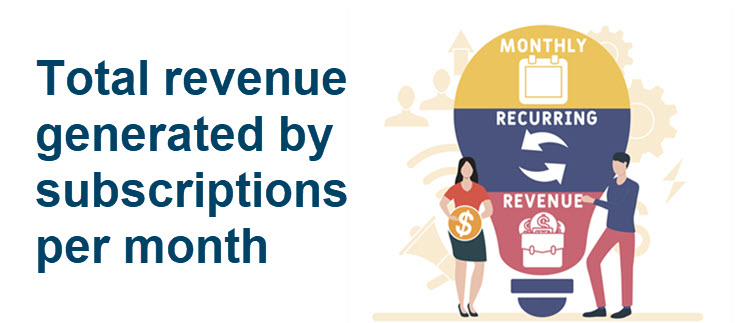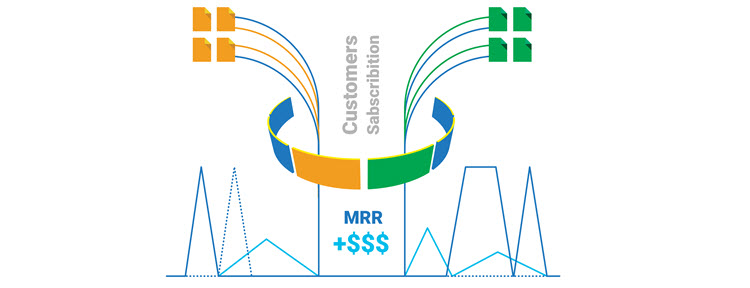Online business activities are undergoing significant changes in payments and service arrangements. Popular business models, such as subscription and membership, are helping online businesses establish a constant flow of recurring revenue.
For any subscription business, it’s important to understand how to calculate monthly revenue and costs.
In this article, you’ll learn what monthly recurring revenue (MRR) is, why it’s important, and how it’s calculated.
MRR Definition

MRR (Monthly recurring revenue) is a metric that shows the total revenue generated by subscriptions per month. Subscription businesses calculate MRR to estimate monthly revenue across different subscription tiers.
This sum is calculated by taking the total number of new subscriptions and upgrades minus all the canceled subscriptions and the value lost to downgrades within a single month.
MRR vs. Revenue: What's the Difference?
Revenue is an accounting metric that indicates the amount of money earned from core business activities like product/service sales, interest rates, or other sources of income. It’s the total income, before deducting business costs and tax payments.
The sum that you get when you deduct your business costs and tax payments from your revenue is called net income.
So, the main difference between MRR and revenue is that MRR is one component of revenue showing the sum of paid subscriptions within one month, while revenue is a more general term referring to all the items sold during an accounting period.
Why Is MRR Important?
MRR is a key figure for subscription-based businesses because it shows current earnings and indicates expected income for the upcoming period.
Platforms relying on content creators and contributors benefit from MRR because it shows how engaging their content is. For them, MRR is a regularly updated metric that clearly shows how many users have started paying a subscription and how many have dropped their subscription.
All these data give subscription-based business owners a reliable standpoint for forecasting their long-term income.
How is MRR Calculated?

The basic calculation of MRR is simple: multiply the number of subscriptions by the monthly price of subscription per user.If there are different subscription tiers, calculate each tier separately. Then, add them together.
Tier 1: For instance, if one subscription plan is $10 per month and you have 200 subscribers, MRR for that tier is $2000 for that month.
Tier 2: If another subscription plan costs $20 per month and there are 50 subscribers to that plan, the total MRR for that tier is $1000.
Total MRR: The total MRR for those two tiers in one month would be $3000 altogether, given that there were no canceled subscriptions.
Read about the differences between monthly and annual subscription models.
Common Mistakes to Avoid When Calculating MRR?

It’s vital for every subscription business to properly calculate MRR to ensure they have accurate data for further calculations.
Here are some common mistakes to avoid when calculating monthly recurring revenue.
Adding Single Payments
Don’t add one-time payments to your MRR calculations. These single payments won’t recur monthly, so they don’t belong here.
Learn the difference between memberships and subscriptions.
Deducting Payment Fees and Other Charges
If you subtract the transaction fees and other charges, such as delinquent charges, from the MRR, the final calculation will be inaccurate.
The fee paid in one period for a subscription transaction might change in the future. You can negotiate lower fees or change the billing solution to make savings. That’s why leaving the transaction fees within the MRR is a better option in the long run.
The same goes for delinquent charges. For instance, if a customer’s credit card has expired or they don’t have enough funds, you won’t be able to collect their subscription. In that case, it’s better to streamline such failed charges into a separate category to get a clear insight into such transactions.
Including Trial Period Subscriptions

As the trial period ends and a subscription becomes active, it’s eligible to become a part of MRR.
Since MRR depends on when in the billing cycle you calculate it, this new subscription is included in MRR as soon as it generates revenue.
Trial customers that don’t convert into subscribers are to be excluded from MRR.
Failing to Include Discounts
When offering discounts to new subscribers, don’t forget to include those offers in your MRR.
Make a separate category for all users that subscribe to your services at the same discounted rate to calculate their share of the MRR accurately.
Registering Annual, Semiannual, and Quarterly Payments as MRR
Some users want to pay several months of their subscription at once. If they’re paying annual, semiannual, or quarterly payments, divide the paid amount by the number of months it includes.
For example, if a monthly subscription is $30 and a client makes a quarterly payment, they’ll transfer $120 to your account. Instead of adding the entire sum to the MRR for that month, add $30/month to each of the following four months.
Note: Learn about Annual Recurring Revenue and how to calculate it in our article What Is ARR (Annual Recurring Revenue).
How to Increase MRR?
Plan smartly and follow the tips below to increase your MRR.
Offer Different Pricing Packages
The more customers you generate, the higher MRR you can expect. One of the most efficient incentives for landing new customers is to offer different pricing packages. Divide the existing pricing system into several tiers to attract customers at different payment levels.
Use Upselling and Cross-Selling Techniques

The existing customer is the best opportunity for increasing MRR.
Give your loyal customers a chance to upgrade to higher tiers via special offers. Since they’re already using your services or products, you’ve already built a certain level of mutual trust. As such, they’re more likely to opt for more products/services. Consequently, your MRR will grow due to the higher amounts of paid monthly subscriptions from those customers.
Likewise, offer similar products or services to incentivize your customers to buy even more items or services from you.
Are you new to the world of subscriptions? Follow our tips on what to do when starting a subscription business.
Invest in Your Products and Services
Satisfied customers are always looking for more. Having a pool of loyal customers obliges you to keep improving your existing products and services.
As you make improvements, apply the tips from the previous paragraph to monetize them.
Conclusion
Monthly recurring revenue is both proof of your past efforts and an indicator of your future expectations.
Calculate the MRR as accurately as possible and include all the relevant components. Accurate MRR helps plan a budget and improves your business offer.
